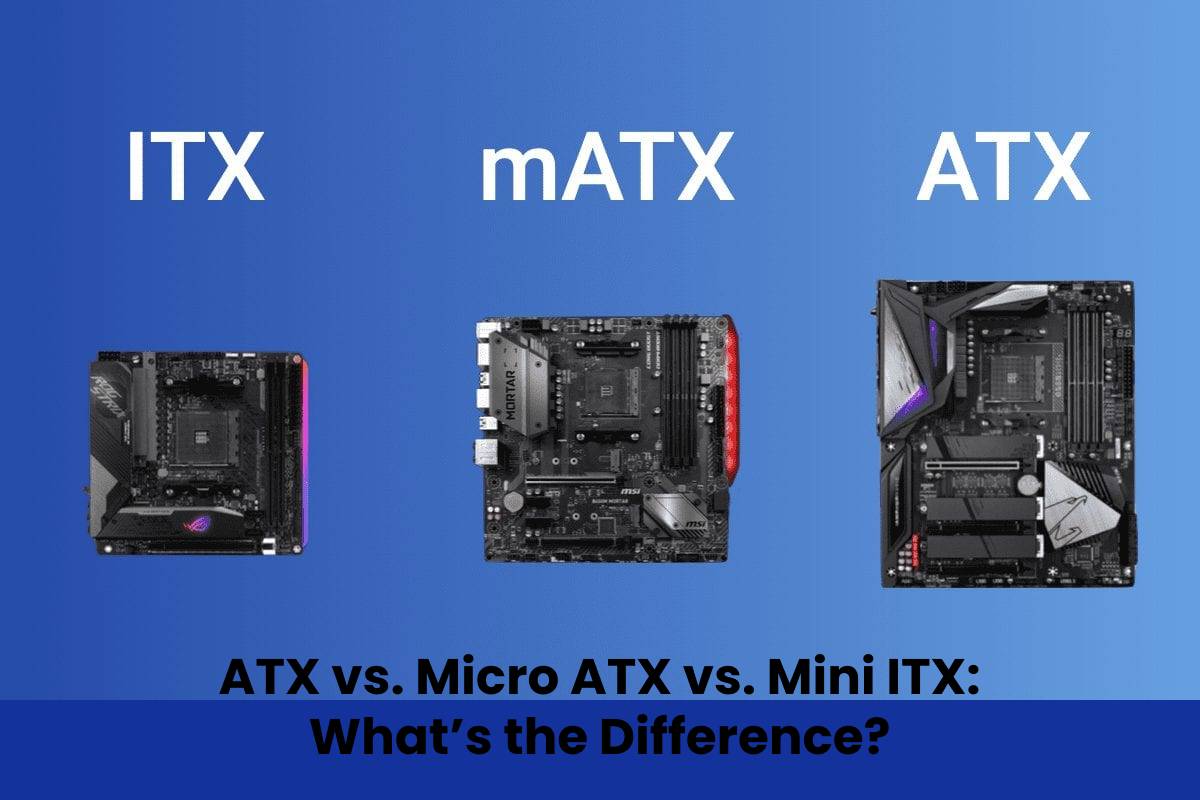

Choosing the Right Motherboard: ATX, Micro‑ATX, and Mini‑ITX Explained
Ready to Upgrade Your PC?
Thinking about swapping out that old motherboard for a shiny new one? Pause there! Before you start hunting around, let’s get a quick refresher on the three main sizes that most people use: ATX, Micro‑ATX, and Mini‑ITX.
Why Size Matters
Think of the motherboard like the spine of your computer. The form factor – that fancy term for size – tells you whether the board will fit inside your case, how many slots it has for expansion, and how many ports you can plug into. Bigger often means more goodies, but also more expensive.
The Big Three
- ATX (Advanced Technology Extended) – The classic champ. Perfect for gamers and power users who want big blocks of RAM, fancy GPUs, and a ton of ports.
- Micro‑ATX – Slightly smaller but still packed with features. Great for a balance between performance and desk space.
- Mini‑ITX – Tiny but mighty. Ideal for tiny rigs or when you want a box that’s almost as compact as a coffee mug.
ATX – The All‑Rounder
Pros:
- Most expansion slots (up to 7).
- Excellent overclocking support.
- Great for high‑end gaming setups.
Cons:
- Large – needs a full‑size case.
- More expensive.
- Can be overkill if you’re just doing basic tasks.
Micro‑ATX – The Compact Powerhouse
Pros:
- Fewer holes for the case, but still loads of slots.
- Good for mid‑range builds.
- More affordable than ATX.
Cons:
- One or two slots less than ATX.
- Still requires a decent size case.
Mini‑ITX – The Tiny Titan
Pros:
- Very small – fits in the tightest cases.
- Great for silent or space‑saving builds.
- Shiny, sleek aesthetics.
Cons:
- Only one RAM slot.
- Limited expansion; usually one PCIe slot.
- Need to sacrifice some features for the size.
Which One Should You Pick?
Consider what you want out of your system:
- If you’re a hardcore gamer and can juggle the space, choose ATX.
- For a solid all‑round machine that doesn’t break the bank, Micro‑ATX is a safe bet.
- If your desk is cramped or you’re building a mini PC for on‑the‑go use, Mini‑ITX is the way to go.
Remember, the right form factor is the key to a smooth, satisfying build. Happy upgrading!
What is a Form Factor?
Getting the Right Motherboard Fit: What Form Factor Means
A motherboard’s form factor is basically the box’s footprint: its overall size, shape, and the clues it drops on where the screws go and where the power wire kisses the board. Think of it as the size of a shoe; the right fit means you’ll stay comfy without stepping out of bounds.
Why It Matters
- Space & Strength – Bigger boards give you more room for extra PCI‑e slots and power‑laden GPUs.
- Mounting Points – Each form factor marks the spots where the case’s frame and power supply latch on.
- Heat & Noise – Smaller panels usually mean tighter airflow, so you’ll have to think about cooling.
The Main Players
ATX (The Classic)
This is the OG standard for desktop builders. It’s large enough to hold plenty of slots, but keep an eye on your case – you’ll need a “full‑size” chassis.
Micro‑ATX (The Slim Champion)
A trimmed‑down cousin that still packs lots of power. It’s great for mid‑tier PCs and fits most compact cases.
Mini‑ITX (The Pocket Power)
This tiny titan is perfect for tiny builds. If you want a “silent” machine that rolls around but still packs a punch, Mini‑ITX is your friend.
Other Variants (Mini‑ECC, Flex‑ATX, etc.)
There are a few niche shapes for specific use cases. Pick them if you’re doing something outside the normal gaming or office swarm.
How to Pick?
- Check the Case – All memory of what board sizes it can cradle.
- Figure Your Needs – Want a single GPU or a dual‑GPU beast? Or maybe just a sound card and a few expansion slots?
- Future Proof – Think about where you’ll upgrade. More slots now means more options later.
- Cooling Comfort – Bigger boards give more room for larger fans and better airflow.
The Final Verdict
For most users, the Micro‑ATX model strikes the winning balance: it’s flexible, roomy, and fits a wide range of cases. Want the biggest feature set? Go ATX. Craving compact and quiet? The Mini‑ITX is your go‑to.
Whichever you pick, remember that a motherboards size is like your home’s floor plan – it’s all about a fit that balances space, comfort, and future growth. Happy building!
ATX (Advanced Technology Extended)
ATX Motherboards: The Classic Reboot
Ever wondered why your gaming rig looks slick and modern while still feeling familiar? Meet the ATX form factor – the OG of motherboard design that first popped onto the scene in 1995.
What Makes ATX a “Baby AT”?
- It’s basically an evolved AT board, but with new tricks.
- Ports are smartly arranged to keep everything clear and avoid those annoying overlaps.
- The edge layout is a whole new ballgame, giving you quick access to everything.
- More drive bays – because you’re going to store all those game discs and tech gadgets.
Why Spend Extra Cash?
If you’re setting up a high‑end gaming or workstation PC, ATX is the go‑to choice. It’s a bit pricey, but the perks are worth it:
- Four memory slots that can handle up to 32 GB per slot – load up all the RAM you need for those crunch‑time streams.
- Flexible GPU and PCIe card support, so you can stack the power you desire.
- Designed for gamers and pros who want extravagant performance without compromises.
Bottom Line
ATX’s blend of classic design and modern upgrades makes it a solid pick for anyone chasing the ultimate PC experience. Set up your station, plug in that next‑gen graphics card, and enjoy a smooth, sophisticated gaming workflow all thanks to the dependable old‑school charm of ATX.
Pros
Why This Platform is a Game‑Changer
Building a PC that can keep up with gaming’s ever‑evolving technology is like picking the perfect pair of shoes—comfort, style, and the ability to go places. This platform delivers on all fronts, giving you the room you need to push the limits.
What Makes It Shine
- Plenty of PCIe slots – More slots mean you can fit extra GPUs, extra sound cards, or even a tiny quantum computer. If you’re the kind of gamer who likes a bit of extra spice, this is your recipe.
- Powerful overclocking support – The architecture lets you raise the clock speeds without worrying about static clank. Think of it as turning up the dial on a giant espresso machine—more energy, more flavor.
- Multiple GPU support – Whether you’re into ray‑tracing dreams or just want a mega‑blend of graphics power, this system can handle it. Dual‑GPU headshots? Bring it on!
- Huge RAM capacity – With more memory space, your games won’t feel like a single‑player, single‑CPU effort. It’s like giving your system a second brain.
- Ready for upgrades – From sliding in a newer chipset to plugging in an extra SSD, this platform evolves with you because it’s designed for hardware upgrades.
- Perfect for high‑end gaming PCs – Every component works in harmony so your gaming rigs perform at their best, just like a well‑tuned orchestra.
Bottom line: If you’re building a rig that can grow with the future of gaming, this platform is the foundation you need.
Cons
Overpriced & Space‑Sucking
What’s the Deal?
Ever bought something that hit you hard at the checkout and made you give up your morning coffee? That’s exactly what this item feels like. It’s pretty expensive, and if you’re like me, you’ll also notice it takes up more room than your armchair.
Buy or Pack?
- Price tag shock: It’ll drain your wallet faster than a Black Friday sale.
- Space thief: Statically, it’s a true “room hog”—it’ll hide under your couch, behind the fridge, and even in the shoes you forgot to put back.
- Budget wise: Your monthly expenses will probably need a side hustle to cover this one.
Bottom line: Is it worth it?
Some folks love the luxury, others love a tidy apartment. Choose your comfort zone. Chuck a laugh if you’re laughing, or a sigh if you’re not.
Micro-ATX
Micro‑ATX: The Small‑But‑Snazzy Motherboard
Micro‑ATX is a slick, space‑saving sibling to the classic ATX chipset. Launched back in 1997, it’s basically the same inside and out as its older cousin—same mounting holes, same layout—so you can pop it right into an ATX case with no fuss.
Why You’ll Love It
- Budget‑friendly: It’s perfect for gamers who want solid performance without blowing the bank.
- Six‑Slot Memory: Four DDR slots give you enough headroom to upgrade or jump‑start your next gaming rig.
- Compact Footprint: Developers’n builders can fit this powerhouse into smaller boxes without sacrificing power.
What It Can’t Do
All that delight comes with a pricing twist: it can host only a single GPU, so if you’re planning a multi‑GPU beast or a high‑end VR set‑up, you might want to look elsewhere.
Bottom Line
Micro‑ATX is the ideal wrist‑sized hero for anyone needing efficient performance on a shoestring budget. Backwards‑compatible, easy to fit, and just right for those who want power without the space crunch.
Pros
Meet the “Dream Box” for Every Gamer Who’s Not a Tech‑Guru
Why You’ll Love It
- One‑GPU Adventure – Only one GPU needed, so you can keep the extra power‑hungry card saved for future upgrades.
- Wallet‑Friendly – It’s a steal? Yep, you can snag it without burning a hole in your bank account.
- ATX‑Mate – Plays well with traditional ATX cases – no weird fidgeting or “where do I mount this?” moments.
- Space‑Saver Supreme – Compact enough to squeeze into almost any case, even those “tiny” ones that look like they could fit your keys.
- Upgraded RAM Game – More room for memory than its Mini‑ITX cousin—so your applications won’t feel cramped.
Feeling the Vibe?
Picture yourself setting up this little powerhouse on your desk, blowing past the clutter, and watching your games run smoother than a well‑oiled racetrack. It’s the kind of build that whispers, “I’m here, I’m solid, and I’m not spending an arm‑and‑a‑leg.” If you’re serious about gaming but not crazy about hardware tweaking, this is your sweet spot.
Cons
Why This Gear is \*
Not a fan of pushing its limits – the machine just won’t play well with overclocking. It prefers to stay chill and deliver solid, reliable performance.
Why it’s a no‑go for overclocking
- Cold‑flow cooling: it doesn’t have the robust circulation needed for extra heat.
- Heat‑tolerant parts: the components are engineered for stability, not speed chases.
- Engineered for longevity: pushing it beyond design specs could short‑circuit your warranty.
Style… if you can call it that
Some might call its look “functional” instead of “fashionable.” The design is plain, pragmatic, and has a bit of an industrial vibe. If you’re into sleek, minimal aesthetics, this might feel a bit underwhelming.
Bottom line
Stick with it if you want dependable performance where “stay‑within‑limits” is the mantra. If you crave high‑speed gaming or a trendier look, you’re probably better off looking elsewhere.
Mini-ITX (Information Technology Extended)
Mini‑ITX: The Tiny Powerhouse
Ever since 2001, the Mini‑ITX motherboard has been the go‑to choice for anyone looking to keep their computer compact yet functional. Its name alone tells you what to expect: it’s the smallest of the gang.
Why Mini‑ITX Rocks
- Fan‑less design – Built to run quietly, no fan means zero whirring.
- Low power consumption – Perfect for power‑sensitive builds.
- Noise‑free operation – Because who wants a noisy PC interrupting their day?
- Four mounting holes – Gives you versatility for placement.
- Standard ATX expansion slots – You can still pop in a single PCIe card.
Memory & Performance
The board supports two DDR modules, capping the total RAM at 32 GB. While this might sound modest compared to larger boards, it’s more than enough for modern titles and everyday multitasking.
When to Hold Your Breath
If you’re dreaming of a high‑end gaming rig, Mini‑ITX doesn’t quite cut the hair out enough. Its limits on RAM and expansion slots mean you’ll have to trade a bit of performance for portability.
Pros
Why this Board is Awesome for Your Next Build
Want a killer gaming rig? This motherboard is the perfect fit—no more fussing over space or performance.
Built to Bring the Boom
- Gaming‑ready out the box: Handles modern titles with ease. Think smoother frames and stronger stability.
- Compact? Piece of cake: It’s a dream for tiny cases—small footprint, big potential.
- Look‑good factor: Aesthetics outshine the typical Micro‑ATX boards—sleek, vibrant, and ready for a spotlight.
Don’t settle for a “good enough” upgrade. This board gives you power, style, and the confidence that your system is built to play.
Cons
Why This Board Won’t Cut It for Hardcore Gamers
Not ideal for hardcore gamers – It’s basically the “stand‑by” version of a PC, perfect for casual browsing but not the battlefield you craved.
Top Three Bummer Factors
- More Expensive Than Micro‑ATX – You’re paying extra for a board that still treats you like a side‑kick.
- Limited Memory Capacity – If you’re into big, graphics‑heavy games, you’ll have to grow your boots from 8 GB to 16 GB or more.
- Game‑Ready Features Missing – It lacks the power‑boosting tricks that make high‑end gamers feel victorious.
In short, if you’re looking to dominate the latest titles or stream in 4K, this board is a stepping stone, not the destination. Choose something that can keep pace with your gear, or upgrade to a board that has more meat to chew on.
Which Motherboard to Pick?
Choosing the Right Motherboard for Your i5‑11400 Build
If you’ve just grabbed an Intel Core i5‑11400, you’re probably bracing for a new PC adventure. The secret sauce isn’t just the processor—your motherboard is the backbone that keeps everything humming. Picking the wrong one can lead to headaches that are louder than a bad Wi‑Fi ping.
What to Think About Before You Buy
- Room to Grow – Do you need space for extra graphics cards or a head‑count of RAM?
- Budget – Bigger boards often mean higher costs.
- Desk Space – Compact systems are great if your desk is a tight squeeze.
Mini‑ITX: The “Supply‑Less” Option
If you’re building a regular desktop and want a sleek footprint, Mini‑ITX can be your best friend. It sports two RAM slots—perfect for a decent memory load—and keeps the case size tight.
Micro‑ATX: The Versatile Middle‑Ground
Want more perks without breaking the bank? Micro‑ATX offers a sweet balance: multiple PCI‑Express slots and a reasonable price tag. It’s ideal for gamers who play mid‑tier titles or for small workstations that could foam up a bit of extra hardware.
ATX: The Heavy‑Hitman for Hardcore Gamers
When you’re aiming to stack up on RAM (say, 16 GB or more) and fly a few graphics cards at once, ATX is the go‑to. It comes with the maximum PCI‑Express lanes and the ability to load a high‑end cooling solution. The trade‑off? The cost, because more versatility usually means a higher price.
Bottom Line
Once you’ve mapped out what you need—whether it’s a powerful gaming rig or a straightforward office PC—you’ll have a clear view of which form factor fits like a glove.
So sit back, pick your motherboards, and let that i5‑11400 unleash its full potential without any form factor woes.







